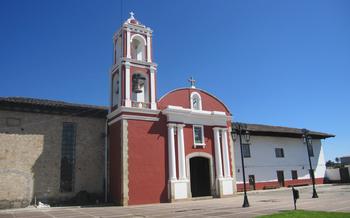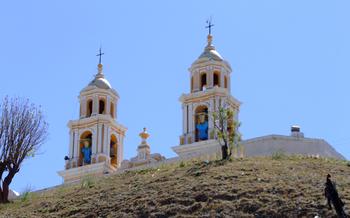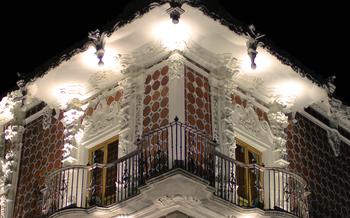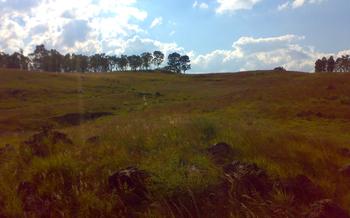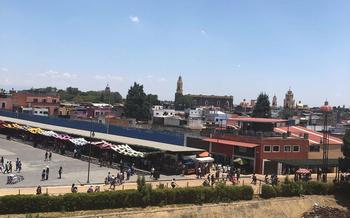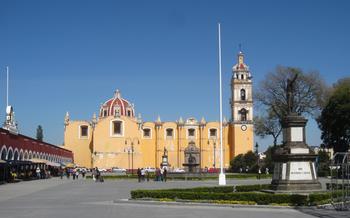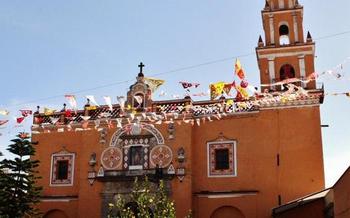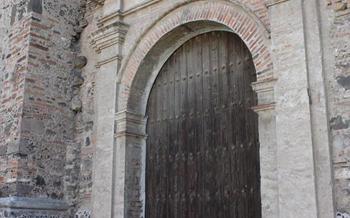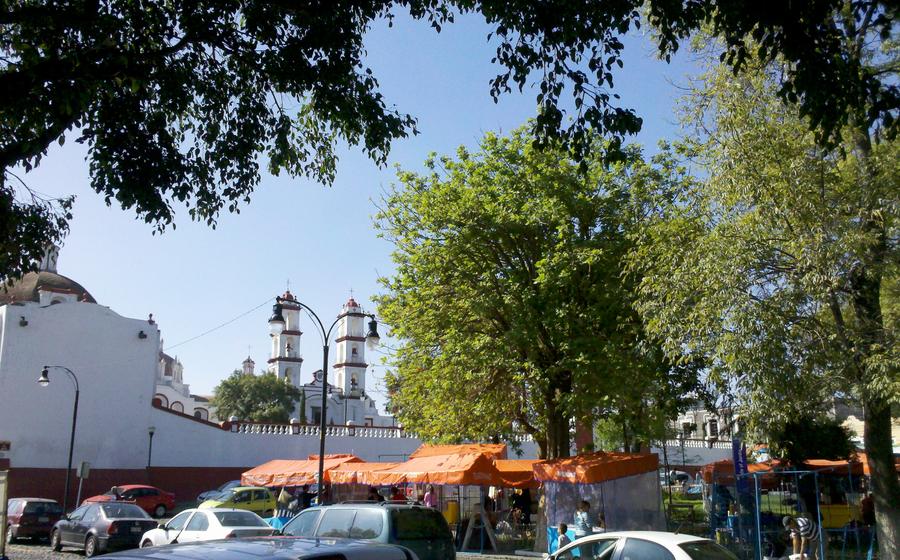
Barrio de Analco
- Visiting the Church of San Francisco
- Discovering the Casa de la Cultura
- Visiting the Talavera Workshops
- Exploring the Museo Regional de Cholula
- Uncovering the Past
- Interactive Experiences
- Cultural Significance
- Attending the Festival de San Francisco
- Shopping for Talavera Pottery
- Learning about Pre-Columbian History
Visiting the Church of San Francisco
The Church of San Francisco stands as a majestic testament to the architectural prowess and religious fervor that shaped Barrio de Analco. Constructed in the 16th century, its Gothic-Renaissance facade captivates visitors with its intricate carvings and sandstone hues. Step inside, and you'll be transported to a realm of spiritual grandeur. The vaulted ceilings, adorned with frescoes depicting biblical scenes, create a sense of awe and reverence. The altar, a masterpiece of Baroque art, shimmers with gold leaf and intricate details, drawing the eyes upward in silent admiration.
Throughout the year, the church buzzes with religious fervor during festivals and celebrations. The annual feast of San Francisco, held in October, transforms the church into a vibrant hub of activity as pilgrims and locals alike gather to pay homage to the patron saint. The air fills with the sounds of music, prayers, and the aroma of incense, creating an atmosphere of profound devotion.
Beyond its religious significance, the Church of San Francisco holds immense historical value. Its sturdy walls have borne witness to the passage of time, from the colonial era to the present day. It has served as a sanctuary for the community, a place of refuge during turbulent times, and a symbol of resilience amidst change.
Discovering the Casa de la Cultura
The Casa de la Cultura, located in the heart of Barrio de Analco, is a vibrant cultural hub that showcases the artistic and historical heritage of the neighborhood. Originally built in the 16th century as a hospital, the building has been transformed into a cultural center that hosts a diverse range of events and exhibitions throughout the year.
Inside the Casa de la Cultura, visitors can explore art galleries featuring local and national artists, attend workshops and classes on traditional crafts and dance, and learn about the history of Barrio de Analco through interactive exhibits. The center also hosts cultural events such as concerts, theater performances, and film screenings, providing a platform for local artists to showcase their talents.
One of the highlights of the Casa de la Cultura is the historical exhibit that tells the story of Barrio de Analco from its pre-Columbian origins to its present-day status as a vibrant cultural hub. Visitors can learn about the neighborhood's role in the Mexican Revolution and its contributions to the city's cultural landscape.
With its rich history, diverse cultural offerings, and beautiful architecture, the Casa de la Cultura is a must-visit destination for anyone interested in exploring the cultural heart of Barrio de Analco.
Visiting the Talavera Workshops
In the heart of Barrio de Analco, the Talavera workshops stand as a testament to the vibrant artistic traditions of Puebla. Step inside these workshops and witness the magic unfold as skilled artisans transform humble clay into exquisite works of art.
The Talavera pottery and tile-making process is a mesmerizing blend of artistry and craftsmanship. Watch as the artisans meticulously mold and shape the clay, creating intricate forms and patterns. The pieces are then carefully glazed and fired, resulting in the distinctive glossy finish that is synonymous with Talavera.
Join a workshop and try your hand at creating your own Talavera piece. Under the guidance of experienced artisans, you'll learn the basics of this traditional craft and create a unique souvenir to cherish.
Stroll through the workshops and admire the stunning array of finished products. From decorative tiles to intricate tableware, each piece is a masterpiece of color and design. Don't miss the opportunity to shop for Talavera souvenirs, making for a beautiful and authentic reminder of your time in Barrio de Analco.
Exploring the Museo Regional de Cholula
Delve into the rich history and cultural heritage of the region at the Museo Regional de Cholula. This captivating museum showcases an array of pre-Columbian artifacts, providing visitors with an immersive journey through the ancient civilizations that once thrived in this land.
Uncovering the Past
Embark on a voyage of discovery as you wander through the museum's various exhibits, where you'll encounter a treasure trove of archaeological wonders. Marvel at intricately carved stone sculptures, delicate pottery adorned with vibrant hues, and fascinating artifacts that shed light on the daily lives and rituals of the region's indigenous peoples.
Interactive Experiences
Engage your senses and delve deeper into the region's history through interactive exhibits that bring the past to life. Explore virtual reality displays, manipulate hands-on replicas of ancient tools, and immerse yourself in multimedia presentations that transport you back in time.
Cultural Significance
Gain a profound understanding of the cultural significance of the region as you learn about the beliefs, traditions, and customs of the ancient inhabitants. Discover the stories behind the artifacts, unravel the mysteries of ancient civilizations, and trace the evolution of cultures that have shaped the identity of this vibrant region.
Attending the Festival de San Francisco
Every year in October, the Barrio de Analco comes alive with the vibrant colors and sounds of the Festival de San Francisco. This annual celebration honors the patron saint of the neighborhood, San Francisco de Asís, and is a testament to the deep religious and cultural traditions of the area.
During the festival, the streets of the barrio are adorned with colorful decorations, and the air is filled with the music of traditional Mexican bands. Religious processions wind their way through the neighborhood, as devotees carry statues of San Francisco and other saints.
The festival is also a time for feasting and merrymaking. Food and craft fairs line the streets, offering a variety of traditional Mexican dishes, handicrafts, and souvenirs. Visitors can indulge in delicious barbacoa, mole poblano, and other regional specialties, while browsing the stalls for unique treasures.
The Festival de San Francisco is a not-to-be-missed event for anyone visiting Puebla. It is a vibrant and authentic celebration that showcases the rich cultural heritage of the Barrio de Analco.
Shopping for Talavera Pottery
When visiting Barrio de Analco, shopping for Talavera pottery is a must. This traditional Mexican ceramic is renowned for its intricate designs and vibrant colors, making it a popular choice for home décor and tableware. You can find Talavera pottery in various shops and workshops throughout the neighborhood, each offering unique pieces.
When shopping for Talavera, take your time to browse and compare prices. You can often find better deals by bargaining with the vendors. Most shops are willing to negotiate, so don't be afraid to ask for a discount. You can also find Talavera pottery at the Mercado de Analco, where you can haggle with the vendors for the best prices.
If you're buying Talavera pottery as a gift, consider the recipient's taste and style. There are many different designs and colors to choose from, so you're sure to find something perfect.
If you're planning on shipping your Talavera pottery purchases home, pack them carefully to avoid breakage. Talavera is a fragile ceramic, so it's important to wrap it in bubble wrap or other cushioning material. You can also ask the shop owner for packing recommendations.
Learning about Pre-Columbian History
The region of Puebla is rich in pre-Columbian history, with several ancient settlements and archaeological sites that shed light on the fascinating civilizations that thrived in the area before the arrival of the Spanish. The region was home to the Olmecs, Zapotecs, and Mixtecs, who left behind impressive ruins and artifacts that offer a glimpse into their advanced cultures.
The most significant pre-Columbian site in the region is the Great Pyramid of Cholula, located just a short distance from Barrio de Analco. Known as Tlachihualtepetl, or "made-by-hand mountain," this massive pyramid is the largest in the Americas by volume and is believed to have been built over several centuries by the Olmecs and later by the Toltecs. Visitors can explore the tunnels and chambers within the pyramid and learn about its construction and significance.
Other notable pre-Columbian sites in the region include the Cacaxtla and Xochicalco archaeological zones, which offer insights into the lives and cultures of the ancient inhabitants of the area. Visitors can admire well-preserved murals, sculptures, and other artifacts that provide a glimpse into the rich artistic and cultural traditions of these ancient civilizations.
